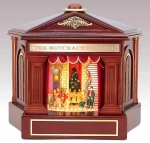|
Add to cart
Product added to the basket The stock is insufficient - units have been added to cart Total:
|
|
Out of stock
|
|
Minimum purchase quantity
The minimum purchase quantity is not reached
|
OUR OFFER
OUR INFORMATION
EXPRESS ORDERS
To know more about the Nutcracker ballet

To know more about the Nutcracker ballet
The story has been published in many book versions including colorful children-friendly versions. The plot revolves around a German girl named Clara Stahlbaum or Clara Silberhaus. In some Nutcracker productions, Clara is called Marie; in others, she is known as Masha. (In Hoffmann's tale, the girl's name actually is Marie or Maria, while Clara - or "Klärchen" - is the name of one of her dolls.)
- Act I
The work opens with a brief "Miniature Overture", which also opens the Suite. The music sets the fairy mood by using upper registers of the orchestra exclusively. The curtain opens to reveal the Stahlbaums' house, where a Christmas Eve party is under way. Clara, her little brother Fritz, and their mother and father are celebrating with friends and family, when the mysterious godfather, Herr Drosselmeyer, enters. He quickly produces a large bag of gifts for all the children. All are very happy, except for Clara, who has yet to be presented a gift. Herr Drosselmeyer then produces three life-size dolls, which each take a turn to dance. When the dances are done, Clara approaches Herr Drosselmeyer asking for her gift. It would seem that he is out of presents, and Clara, in some productions, runs to her mother in a fit of tears and disappointment. In others, she is still quite happy; in Baryshnikov's version, she whispers into Drosselmeyer's ear, presumably gently hinting that she would like a toy.
Drosselmeyer then produces a toy Nutcracker, in the traditional shape of a soldier in full parade uniform. Clara is overjoyed, but her brother Fritz is jealous, and breaks the Nutcracker.
The party ends with Tchaikovsky quoting the traditional German dance tune, the Grossvater Tanz, and the Stahlbaum family go to bed. While everybody is sleeping, Herr Drosselmeyer repairs the Nutcracker. Then Clara wakes up and sees her window open. When the clock strikes midnight, Clara hears the sound of mice. She wakes up (or is she still dreaming?) and tries to run away, but the mice stop her. In most productions, the Christmas tree suddenly begins to grow to enormous size, filling the room. The Nutcracker comes to life, he and his band of soldiers rise to defend Clara, and the Mouse King leads his mice into battle. Here Tchaikovsky continues the miniature effect of the Overture, setting the battle music predominantly in the orchestra's upper registers.
A conflict ensues, and when Clara helps the Nutcracker by throwing her shoe at the Mouse King, the Nutcracker seizes his opportunity and stabs him. The mouse dies. (In some productions, she merely grabs the Mouse King by the tail, and in others Clara kills the Mouse King when she throws her slipper at him.) The mice retreat, taking their dead leader with them. The Nutcracker is then transformed into a prince. (In Hoffmann's original story, and in the Royal Ballet's 1985 and 2001 versions, the Prince is actually Drosselmeyer's nephew, who had been turned into a Nutcracker by the Mouse King, and all the events following the Christmas party have been arranged by Drosselmeyer in order to break the spell.)
Clara and the Prince travel to a world where dancing Snowflakes greet them and fairies and queens dance, welcoming Clara and the Prince into their world. The score conveys the wondrous images by introducing a wordless children's chorus. The curtain falls on Act I.
Act II
Clara and the Prince arrive at the Land of the Sugar Plum Fairy. The Sugar Plum Fairy and the people of the Land of Sweets dance for Clara and the Prince in the dances of Dew Drop Fairy, the Spanish dancers (sometimes Chocolate), the Chinese dancers (sometimes Tea), the Arabian dancers (sometimes Coffee), the Russian dancers (sometimes Candy Canes—their dance is called the Trepak), Mother Ginger and her Polichinelles - sometimes Bonbons, Taffy Clowns, or Court Buffoons (as in Baryshnikov's production), the Reed Flutes (sometimes Marzipan shepherds or Mirlitons), the Sugar Plum Fairy, and the Waltz of the Flowers. The dances in the Land of the Sugar Plum Fairy are not always performed in this order.
After the festivities, Clara wakes up under the Christmas tree with the Nutcracker toy in her arms and the curtain closes. (In Balanchine's version, however, she is never shown waking up; instead, after all the dances in the Kingdom of Sweets have concluded, she rides off with the Nutcracker/Prince on a Santa Claus-like flying sleigh, complete with reindeer, and the curtain falls. This gives the impression that the "dream" actually happens in reality, as in Hoffmann's original story. The 1985 Royal Ballet version seems to imply the same thing, since at the end, Drosselmeyer's nephew, who had really been transformed into a nutcracker, reappears in human form at the toymaker's shop.)
To know more about the Nutcraker ballet
|
Alert
Please enter the required fields! |